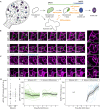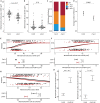A cell size threshold triggers commitment to stomatal fate in Arabidopsis
- PMID: 37729402
- PMCID: PMC10881030
- DOI: 10.1126/sciadv.adf3497
A cell size threshold triggers commitment to stomatal fate in Arabidopsis
Abstract
How flexible developmental programs integrate information from internal and external factors to modulate stem cell behavior is a fundamental question in developmental biology. Cells of the Arabidopsis stomatal lineage modify the balance of stem cell proliferation and differentiation to adjust the size and cell type composition of mature leaves. Here, we report that meristemoids, one type of stomatal lineage stem cell, trigger the transition from asymmetric self-renewing divisions to commitment and terminal differentiation by crossing a critical cell size threshold. Through computational simulation, we demonstrate that this cell size-mediated transition allows robust, yet flexible termination of stem cell proliferation, and we observe adjustments in the number of divisions before the differentiation threshold under several genetic manipulations. We experimentally evaluate several mechanisms for cell size sensing, and our data suggest that this stomatal lineage transition is dependent on a nuclear factor that is sensitive to DNA content.
Figures





Similar articles
-
Sterols are required for cell-fate commitment and maintenance of the stomatal lineage in Arabidopsis.Plant J. 2013 Jun;74(6):1029-44. doi: 10.1111/tpj.12190. Epub 2013 Apr 27. Plant J. 2013. PMID: 23551583
-
Single-cell resolution of lineage trajectories in the Arabidopsis stomatal lineage and developing leaf.Dev Cell. 2021 Apr 5;56(7):1043-1055.e4. doi: 10.1016/j.devcel.2021.03.014. Dev Cell. 2021. PMID: 33823130 Free PMC article.
-
Irreversible fate commitment in the Arabidopsis stomatal lineage requires a FAMA and RETINOBLASTOMA-RELATED module.Elife. 2014 Oct 10;3:e03271. doi: 10.7554/eLife.03271. Elife. 2014. PMID: 25303364 Free PMC article.
-
Stomatal differentiation: the beginning and the end.Curr Opin Plant Biol. 2015 Dec;28:16-22. doi: 10.1016/j.pbi.2015.08.005. Epub 2015 Sep 5. Curr Opin Plant Biol. 2015. PMID: 26344486 Review.
-
Stomatal development.Annu Rev Plant Biol. 2007;58:163-81. doi: 10.1146/annurev.arplant.58.032806.104023. Annu Rev Plant Biol. 2007. PMID: 17201685 Review.
Cited by
-
Developmental timing in plants.Nat Commun. 2024 Mar 27;15(1):2674. doi: 10.1038/s41467-024-46941-1. Nat Commun. 2024. PMID: 38531864 Free PMC article. Review.
-
Cell state transitions: catch them if you can.Development. 2023 Mar 15;150(6):dev201139. doi: 10.1242/dev.201139. Epub 2023 Mar 17. Development. 2023. PMID: 36930528 Free PMC article.
-
AGAMOUS mediates timing of guard cell formation during gynoecium development.PLoS Genet. 2023 Oct 11;19(10):e1011000. doi: 10.1371/journal.pgen.1011000. eCollection 2023 Oct. PLoS Genet. 2023. PMID: 37819989 Free PMC article.
-
Experimental validation of the mechanism of stomatal development diversification.J Exp Bot. 2023 Sep 29;74(18):5667-5681. doi: 10.1093/jxb/erad279. J Exp Bot. 2023. PMID: 37555400 Free PMC article.
-
Eukaryotic cell size regulation and its implications for cellular function and dysfunction.Physiol Rev. 2024 Oct 1;104(4):1679-1717. doi: 10.1152/physrev.00046.2023. Epub 2024 Jun 20. Physiol Rev. 2024. PMID: 38900644 Free PMC article. Review.
References
MeSH terms
Grants and funding
LinkOut - more resources
Full Text Sources

